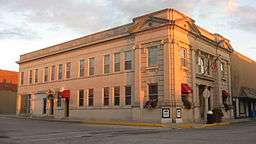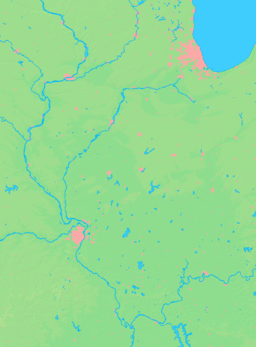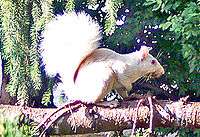Olney, Illinois
| Olney, Illinois | |
| City | |
 Front and northern side of the Olney CNB Bank, located at 202 S. Whittle Street in Olney | |
| Motto: "Home of the white squirrel" | |
| Country | United States |
|---|---|
| State | Illinois |
| County | Richland |
| Coordinates | 38°44′N 88°5′W / 38.733°N 88.083°WCoordinates: 38°44′N 88°5′W / 38.733°N 88.083°W |
| Area | 6.66 sq mi (17 km2) |
| - land | 6.66 sq mi (17 km2) |
| - water | 0.00 sq mi (0 km2) |
| Population | 8,631 (2000) |
| Density | 1,498.4/sq mi (579/km2) |
| Timezone | CST (UTC-6) |
| - summer (DST) | CDT (UTC-5) |
| Postal code | 62450 |
| Area code | 618 |
  Location of Olney within Illinois | |
| Wikimedia Commons: Olney, Illinois | |
Olney (/ˈɔːlni/ AWL-nee) is a city in Richland County, Illinois, United States. The population was 8,631 at the 2000 census. It is the county seat of Richland County.[1]
History
Settlement of the Richland County area began around 1815 when Thaddeus Morehouse, a native of Vermont, arrived by wagon and built a log cabin along a stagecoach route that ran from Vincennes, Indiana to St. Louis. This log cabin operated as a hotel and tavern.
Richland County was organized as a county in 1841, when it was formed by a partitioning of Clay and Lawrence Counties. There was some controversy regarding the location of the county seat; however, Olney was determined as the choice based on a donation of land and the central location. The name of the town Olney was suggested by Judge Aaron Shaw who desired to honor a friend, Nathan Olney. It was not until 1848 that Olney was incorporated as a village.
The Civil War brought a great deal of turmoil to the county as there were sympathies for both sides. President Lincoln and Stephen Douglas spoke at separate political rallies in Olney on September 20, 1856. While most citizens rallied around the Union it was necessary to have troops stationed in Olney to enforce the draft as union deserters found refuge among local citizens. Overall, the county was pro-Union and an estimated 1,700 Richland County citizens fought for the Union in the Civil war. Nearly 1,000 Olney residents served in World War I, and during World War II, Richland County may have been the only Illinois county outside of Cook that provided 4 generals for the war effort.
The first census of Richland County was in 1850 at which time 4,012 people resided in the county. One hundred years later the 1950 census found a spot north of Olney near Dundas to be the population center of the United States.
Squirrel population

Olney is known for its population of white squirrels. There are two hypotheses about how there came to be white squirrels in Olney.[2]
The first is that in 1902 William Stroup was out hunting and shot a gray female squirrel. The shot knocked the two babies out of a nest, and he brought them home to his children. They were later sold to Jasper Banks, who put them on display in front of his saloon.
The second is that George W. Ridgely and John Robinson captured a cream colored squirrel and then raised several litters of them before bringing a pair to Olney in 1902. Mr. Ridgely sold the pair to Jasper C. Banks for $5 each. Mr. Banks made a green box for his albinos and displayed them in his saloon window.
In 1910, the Illinois legislature passed a law prohibiting the confinement of wildlife, and they were released into the woods.
In 1925, the city passed a law that disallowed dogs from running at large. In 1943, the squirrel population reached its peak at 1000, but now the population holds steady at around 200.
In the mid-1970s, John Stencel, instructor at Olney Central College, received a small grant from the Illinois Academy of Science to study the white squirrels.
A squirrel count is held each fall. Both white and gray squirrels are counted in addition to cats. The number of squirrels has dropped causing concern. When the white squirrels dip below 100, they are concerned about genetic drift, or changes in allele (gene) frequency, which may reduce genetic variation and therefore speed up the extinction of a small population.
In 1997, the Olney City Council amended its ordinance which disallowed dogs from running at large to include cats. The 1997 squirrel count realized a decrease in cats. They are hopeful this will have a positive effect on the white squirrel population.
White squirrels have the right-of-way on all public streets, sidewalks, and thoroughfares in Olney, and there is a $750 fine for running one over.[3] The police department’s badge even has a picture of a white squirrel on it. The white squirrel has proved to be an enduring symbol of Olnean pride, and stands as Olney's most defining feature.
The population of white squirrels makes Illinois the only state to have populations of white as well as black squirrels, the latter residing in the Quad Cities area.
Geography
Olney is located at 38°44′N 88°5′W / 38.733°N 88.083°W (38.7306, -88.0819).[4]
According to the 2010 census, Olney has a total area of 6.664 square miles (17.26 km2), of which 6.66 square miles (17.25 km2) (or 99.94%) is land and 0.004 square miles (0.01 km2) (or 0.06%) is water.[5]
Demographics
| Historical population | |||
|---|---|---|---|
| Census | Pop. | %± | |
| 1860 | 1,435 | — | |
| 1870 | 2,680 | 86.8% | |
| 1880 | 3,512 | 31.0% | |
| 1890 | 3,831 | 9.1% | |
| 1900 | 4,260 | 11.2% | |
| 1910 | 5,011 | 17.6% | |
| 1920 | 4,491 | −10.4% | |
| 1930 | 6,140 | 36.7% | |
| 1940 | 7,831 | 27.5% | |
| 1950 | 8,612 | 10.0% | |
| 1960 | 8,780 | 2.0% | |
| 1970 | 8,974 | 2.2% | |
| 1980 | 9,026 | 0.6% | |
| 1990 | 8,664 | −4.0% | |
| 2000 | 8,631 | −0.4% | |
| 2010 | 9,115 | 5.6% | |
| Est. 2015 | 9,005 | [6] | −1.2% |
As of the census[8] of 2000, there were 8,631 people, 3,755 households, and 2,301 families residing in the city. The population density was 1,498.4 people per square mile (578.5/km²). There were 4,283 housing units at an average density of 743.5 per square mile (287.1/km²). The racial makeup of the city was 97.67% White, 0.48% African American, 0.16% Native American, 0.64% Asian, 0.03% Pacific Islander, 0.32% from other races, and 0.70% from two or more races. Hispanic or Latino of any race were 0.96% of the population.
There were 3,755 households out of which 28.2% had children under the age of 18 living with them, 47.4% were married couples living together, 10.6% had a female householder with no husband present, and 38.7% were non-families. 33.7% of all households were made up of individuals and 17.3% had someone living alone who was 65 years of age or older. The average household size was 2.26 and the average family size was 2.89.
In the city the population was spread out with 23.8% under the age of 18, 9.1% from 18 to 24, 25.6% from 25 to 44, 21.0% from 45 to 64, and 20.5% who were 65 years of age or older. The median age was 39 years. For every 100 females there were 86.9 males. For every 100 females age 18 and over, there were 82.4 males.
The median income for a household in the city was $28,084 and the median income for a family was $37,365. Males had a median income of $29,547 versus $18,440 for females. The per capita income for the city was $16,218. About 13.0% of families and 17.0% of the population were below the poverty line, including 21.9% of those under age 18 and 8.0% of those age 65 or over.
Parks
Olney has several parks to enjoy—all of which serve different purposes:
- Olney City Park: A great place to visit if you are looking for the famous white squirrels. Also home to the city playground, 4-H livestock buildings, covered pavilions, and public tennis courts
- Alvin Musgrove Park: A family fun place to visit. Enjoy using the aquatic center, playground, lighted basketball courts, soccer field, and skateboard park. It is also home to the recently constructed little league baseball and softball diamonds.
The park is one of the premier sports parks in southern Illinois, drawing thousand of spectators and athletes to the City of Olney every summer.
- Kiwanis/Rotary Park: The only public access point for boating on East Fork Lake. The only spot to play disc golf in Olney. This location also has a covered pavilion, old softball diamond, and public swimming in East Fork Lake.
- Miller's Grove & Bird Haven: A wonderful place to watch the white squirrels and to go fishing on East Fork Lake. Bird Haven is a bird and plant sanctuary that was bought and developed by the ornithologist Robert Ridgway. This also is the burial place of Ridgway and his wife Julia.
- Bower Park: Originally named Tower Park, in 1880 a 125-foot brick water tower was built on the site. The water tower was demolished in 1941. This is a very small park with flowers and a few benches to sit on located in town.
Education
Post-secondary education
Notable people
- Terry L. Bruce, Illinois State Senator and United States Congressman; born in Olney[9]
- Glenn Brummer, catcher for the St. Louis Cardinals and Texas Rangers[10]
- Glenn Goodart, hotel manager and politician; died in Olney in 1948
- Reginald C. Harmon, first US Air Force Judge Advocate General; Mayor of Urbana, Illinois; born in Olney[11]
- Dummy Murphy, shortstop for the Philadelphia Phillies; born in Olney[12]
- Ollie Pickering, outfielder for the six Major League Baseball teams; born in Olney[13]
- Stan Royer, infielder for the Boston Red Sox and St. Louis Cardinals; born in Olney[14]
- Elaine Shepard, actress; born in Olney
Media
Olney is served by a daily newspaper, the Olney Daily Mail. WUSI-TV (Channel 16) is licensed to Olney. Studio and tranmitter are located outside of town. WUSI-TV is a PBS affiliate operated by the Broadcasting Service of Southern Illinois University.
References
- ↑ "Find a County". National Association of Counties. Retrieved 2011-06-07.
- ↑ "White Squirrels of Olney". City of Olney, Illinois. Retrieved 17 July 2007.
- ↑ "City of Olney Municipal Code" (PDF). p. 7. Retrieved 26 August 2013.
- ↑ "US Gazetteer files: 2010, 2000, and 1990". United States Census Bureau. 2011-02-12. Retrieved 2011-04-23.
- ↑ "G001 - Geographic Identifiers - 2010 Census Summary File 1". United States Census Bureau. Retrieved 2015-12-27.
- ↑ "Annual Estimates of the Resident Population for Incorporated Places: April 1, 2010 to July 1, 2015". Retrieved July 2, 2016.
- ↑ "Census of Population and Housing". Census.gov. Retrieved June 4, 2015.
- ↑ "American FactFinder". United States Census Bureau. Retrieved 2008-01-31.
- ↑ "BRUCE, Terry Lee, (1944 - )". Biographical Directory of the United States Congress. Retrieved February 11, 2014.
- ↑ "Glenn Edward Brummer". Baseball-Reference.Com. Retrieved February 11, 2014.
- ↑ Kerns, Patricia (2004). The First 50 Years: U.S. Air Force Judge Advocate General's Department. Government Printing Office. p. 190.
- ↑ "Herbert Courtland Murphy". Baseball-Reference.Com. Retrieved February 11, 2014.
- ↑ "Ollie Pickering". Baseball-Reference.Com. Retrieved February 11, 2014.
- ↑ "Stanley Dean Royer". Baseball-Reference.Com. Retrieved February 11, 2014.
External links
| Wikisource has the text of the 1911 Encyclopædia Britannica article Olney, U.S.A.. |